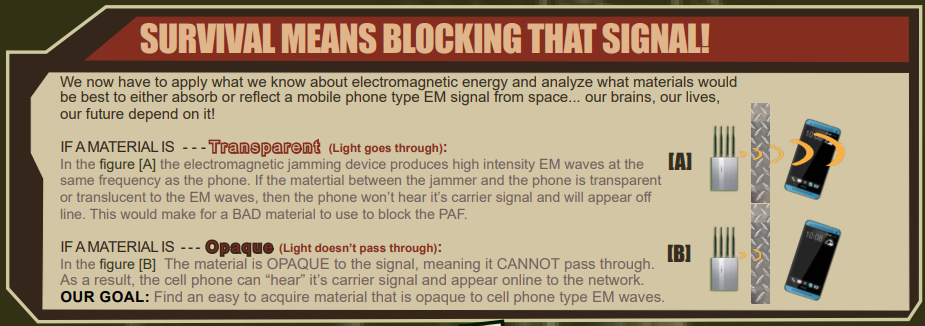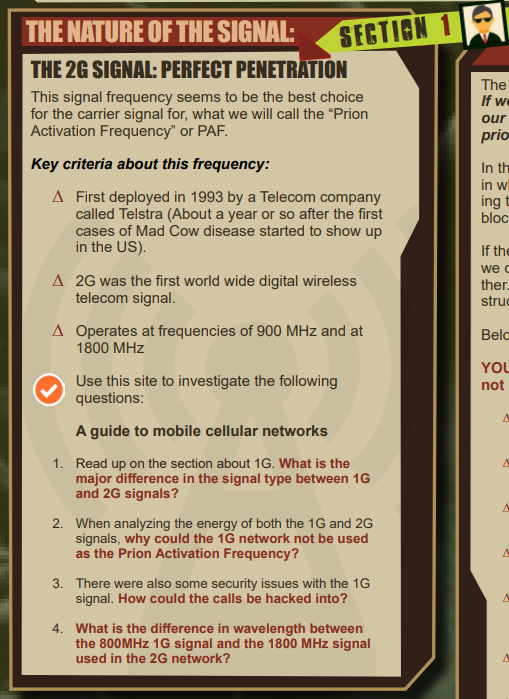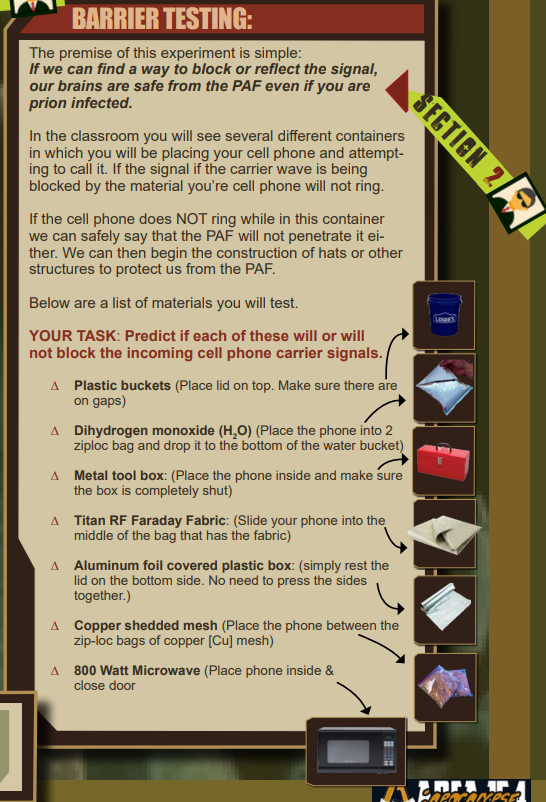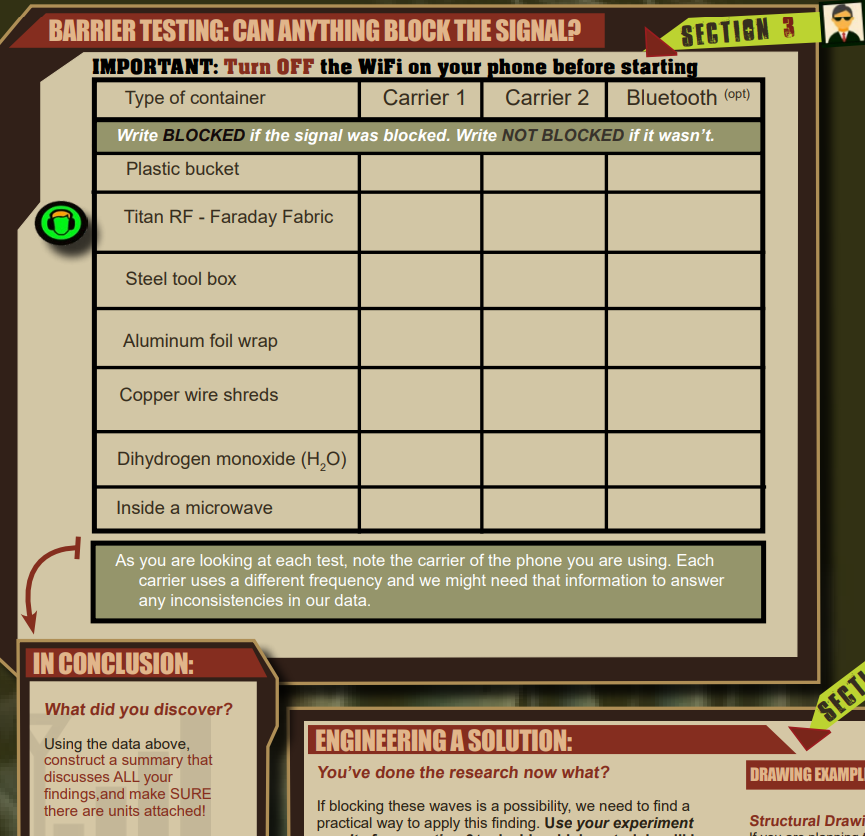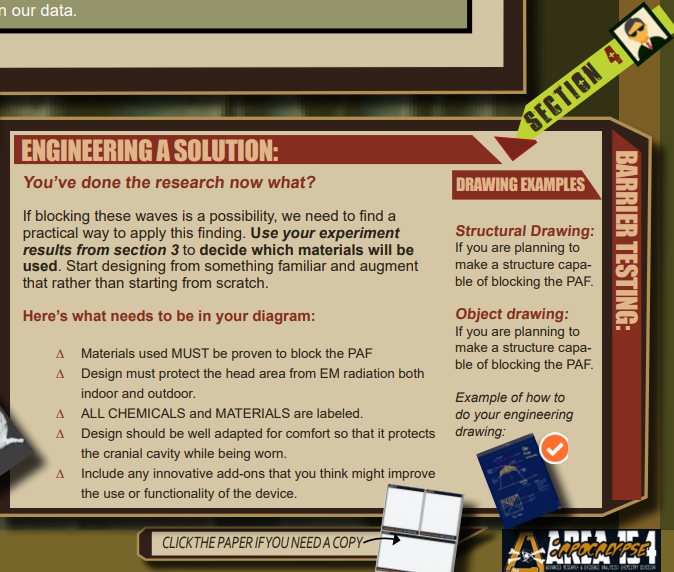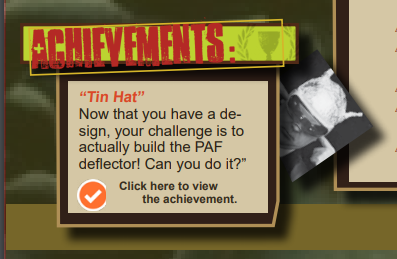Training THREE Guide
Informational Section:
(Est. Time = 5-10 min)
Survival means blocking that signal. Period.
In the last training we talked about the energy levels inside the atom and what happens when electrons are energized enough to move up and then fall back down. This mechanism is the fundamental reason why certain substances will let EM waves pass right through them (transparent) or be completely blocked (Opaque).
Key informational points:
- The point should be made that figure A shows waves passing through. This means that the EM waves did not have the right amount of wave energy to be absorbed by the electrons in that particular substance.
— - Figure B demonstrates what happens when a signal is blocked and the EM waves are absorbed.
— - TAKE AWAY. We can use our phones to test if certain substances have the ability to block cellular signals. If these substances can block cell signals, they could very likely block the prion activation frequency.
Section ONE: (Est. Time = 10 min)
The 2G Signal: Prime Suspect?
There is a “Director’s Briefing icon” linked to video instructions for the section so the students know exactly how to do the work.
This section was placed here to provide some informational backstory to the origin of the cellular networks (as least the publicly accessible reasons)
Key informational points:
- The point should be made that figure A shows waves passing through. This means that the EM waves did not have the right amount of wave energy to be absorbed by the electrons in that particular substance.
— - Figure B demonstrates what happens when a signal is blocked and the EM waves are absorbed.
— - TAKE AWAY. We can use our phones to test if certain substances have the ability to block cellular signals. If these substances can block cell signals, they could very likely block the prion activation frequency.
Section TWO: (Est. Time = 15 min)
Every wave is made of two parts:
There is a “Director’s Briefing icon” linked to video instructions for the section so the students know exactly how to do the work.
IMPORTANT MATERIALS NOTE: The materials listed in section 2 are suggestions and will need to be acquired BY THE PROGRAM IMPLEMENTATION DIRECTOR – that’s you.
Materials suggested here:
- Thick plastic buckets – found at major tool stores
- Water – either in the bucket or in a ZipLoc bag
- Tool box (metal) – Thin gauge steel.
- Titan RF Fabric – optional purchase to investigate just how effective professional EM isolation materials are compared to other materials.
- Aluminum foil – Heavy duty works better
- Copper metal – sheets or filings in a plastic bag
- A microwave – Borrowed from the teachers lounge – make a special note of the grid that is one the front of the oven screen.
- Other options – think about what you have access to and feel free to test it. Additional knowledge about these substances is always good to have
There’s no “write answers” here as these are predictions. To expand the intellectual value of the exercise, encourage the students to phrase their predictions like this:
I think that (material) will be (opaque or transparent) to the (student name’s their cell phone provider)’s carrier signal at (student places the frequency range of their provider’s band)
If you want more information about the frequency carrier bands for each of the cell phone providers, that info can be acquired by accessing this link: Click here.
Section THREE: (Est. Time = 40 min)
Barrier Testing: Can anything stop the signal?
There is a “Director’s Briefing icon” linked to video instructions for the section so the students know exactly how to do the work.
The idea in this experiment involved the use of two (2) cell phones, ideally from different providers. The students will put one phone inside the material barrier and the other will attempt to call the phone. Two results can happen:
Place each of the blocking materials in a “station” type of layout so students can go to any material test area they want. There’s no order to the testing that needs to be kept.
Each student will need to recreate this table in their ATNs. It’s not a small chart and may take up to 15 minutes for students to finish the copying procedure. Evidence suggests students tend to make the tables smaller than they should be. Suggest the table should cover at least 1/2 of a page.
- If the phone rings: The carrier signal can pass through the material and the student would write NOT BLOCKED in the grid.
- If the phone does not ring: The carrier signal cannot pass through the material and the student would write BLOCKED.
— - An optional test would be to test Bluetooth devices. Usually this is done with wireless headphones like the Apple Air Pods or similar. Here’s what could happen:
– No change music keeps playing = NOT BLOCKED
– Music stops = BLOCKED
CONCLUSION: The student’s conclusions will vary due to a number of reasons, but the important part to this activity is the “Claim, evidence, reasoning” part. In their conclusion they should:
- Restate their claim (based on the evidence)
- Provide a summary of the evidence, not a complete retelling, just a summary.
- Provide the reasons why their claim is supported.
For example:
The evidence supports the idea that copper, aluminum the Titan RF fabric and possibly the materials in the microwave oven could block the prion activation frequency. (Claim)
Only copper, the microwave, Titan RF fabric, and the aluminum foil demonstrate any ability to block a cell phone carrier signal. (Evidence)
In the experiment, tests using an AT&T iPhone and a Sprint Samsung smartphone, both phones were blocked by the same materials. However, the Samsung (Sprint) phone was also blocked by the water bucket. (Reasoning based on evidence)
Section FOUR (Est. Time = 35 min)
The source of all light – it’s all made the same.
There is a “Director’s Briefing icon” linked to video instructions for the section so the students know exactly how to do the work.
STEM APPLICATION:
The students, now having evidence for what might work and what might not, are going to make an engineering diagram of a protective structure that could protect them inside and outside until the PAF goes away.
The check it out icon link opens up an example of what the diagram might look like.
The paper link will provide a template that can be used by students to draw their ideas. (Option: You (the director) print out copies of these for each student and they can cut them out and put the finished drawings in their ATNs when done – glue sticks are best for this.)
The diagram requirements are listed here on the left.
Sample Engineering Diagrams
[DRAW]
Click here to for the engineering diagram example.
Ideas: (Assumption is that the PAF comes from geosynchronous satellites in space. The signal comes straight down.)
- A tent – group coverage
- Umbrella – portable tent
- Helmet – will need to cover the face as well.
- Sombrero that is covered with the right materials
- A sleeping chamber – protection at night
- Combo hat-umbrella device
Achievement (Est. Time = 2-3 hrs)
The “Tin Hat” Achievement (40pts)
Back in the 1960s and 1970s the slur given to critical thinkers who started to put the governments plans together were referred to as “Tin foil hat” conspiracy theorists. After this experiments, makes one think that maybe they were on to something…
What you have to do:
You task is to MAKE the device you designed. Once completed, bring it in for testing. Student’s get the achievement for the attempt and an additional bonus if the thing actually works.

